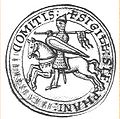History
This lineage came from Theobald the Elder, viscount of Tours before 908. Theobald became viscount of Blois before 922. Afterwards the House of Blois accumulated the counties of Blois, Chartres, Châteaudun and as successors of Herbertians the counties of Troyes, Reims and Meaux - core of the County of Champagne, and finally the kingdom of Navarre.
The House of Blois-Champagne, which was founded by Theobold II in 1025, split into several branches. The House of Blois-Chartres, which was founded by Theobold V of Blois inherited the counties of Blois and Chartres and others in 1152. His descendants would hold the counties until the deaths of Margaret and Isabella, to which the branch became extinct in 1249. The House of Blois-Navarre, which was founded by Theobold I of Navarre, when he inherited the throne from his uncle, Sancho Garcés VI. This branch became the senior line later and eventually became extinct in 1305 with the death of Joan I of Navarre, wife of Philip IV of France. Champagne and Navarre passed to the Capetian dynasty. The House of Sancerre, which was founded by Stephen I, Count of Sancerre, a younger son of Theobold II, Count of Champagne. He inherited the county on his father's death. This branch became extinct at the death of Margaret of Sancerre in 1418 or 1419. The final branch, the House of Lacarre, which was founded by Juan Enriquez, the illegitimate son of Henry I of Navarre.
When Louis VII of France was greatly threatened by the vast collection of territories in the person of Henry II of England, he chose a wife from the House of Blois-Champagne (Adela of Champagne) as a counterpoise to Angevin power.
When William married the Lady of Sully, Adela, sometime after 1100, he became jure uxoris Count or Lord of Sully. This would make him establish a cadet branch in Sully. This branch would also form its own cadet branch, the House of Sully-Beaujeu, which was when Odo, the son of Gilles III, Lord of Sully, acquired the Lordship of Beaujeu.
Sometime during or past 1126, Odo I was taken over by his maternal family. He then became Lord of Champlitte, which he likely inherited from his mother, Isabella, or from the generosity of his uncle Renaud III, Count of Burgundy. [1] He in turn would establish a new cadet branch in Champlitte. This Branch would also establish its own branch, the House of Champlitte-Pontailler. Which was when William I, son of Odo I, acquired the Lordship of Pontailler.
King Stephen I of England, 1135–1154, was both a member of the House of Blois and the last Anglo-Norman King, being the grandson of William the Conqueror through his daughter Adela of Normandy. [2]
A branch of the family was established in Sancerre by Stephen I of Sancerre, a younger son of Theobald II, Count of Champagne. This branch became extinct at the death of Margaret of Sancerre in 1418 or 1419.















































